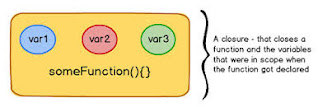Introduction to JavaScript Variables:
In JavaScript, variables are used to store and manage data. A variable is a symbolic name (an identifier) for a value. Variables are declared using the var, let, or const keyword, and they can hold various types of data, such as numbers, strings, or objects.
Here are the main ways to declare variables in JavaScript:
1. var:
The var keyword was traditionally used for variable declaration in JavaScript. However, it has some scoping issues, and it is recommended to use let and const instead.
Example:
javascript
var x = 10;
 |
| JavaScript Variables |
2. let:
The let keyword is introduced in ECMAScript 6 (ES6) and is widely used for variable declaration.
Variables declared with let are block-scoped.
Example:
javascript
let message = “Hello, World!”;
3. const:
The const keyword is also introduced in ES6 and is used to declare constants.
Variables declared with const cannot be reassigned.
Example:
javascript
const pi = 3.14;
JavaScript is a loosely-typed language, meaning that the type of a variable is not explicitly defined. The type of a variable can change during the execution of a program. Here’s an example:
javascript
let age = 25; // age is a number
age = “Twenty-Five”; // age is now a string
In this example, the variable age is first assigned a number, and later, it is reassigned as a string.
It’s important to choose meaningful names for variables to make the code more readable and maintainable. Additionally, following naming conventions, such as using camelCase, is a common practice in JavaScript.